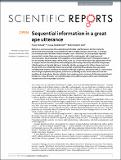Files in this item
Sequential information in a great ape utterance
Item metadata
| dc.contributor.author | Fedurek, Pawel | |
| dc.contributor.author | Zuberbühler, Klaus | |
| dc.contributor.author | Dahl, Christoph D. | |
| dc.date.accessioned | 2016-12-22T16:30:21Z | |
| dc.date.available | 2016-12-22T16:30:21Z | |
| dc.date.issued | 2016-12-02 | |
| dc.identifier | 248496627 | |
| dc.identifier | e9fc38cd-e211-494f-a740-b4c37f65b9d7 | |
| dc.identifier | 85002991025 | |
| dc.identifier | 000389300200001 | |
| dc.identifier.citation | Fedurek , P , Zuberbühler , K & Dahl , C D 2016 , ' Sequential information in a great ape utterance ' , Scientific Reports , vol. 6 , 38226 . https://doi.org/10.1038/srep38226 | en |
| dc.identifier.issn | 2045-2322 | |
| dc.identifier.other | ORCID: /0000-0001-8378-088X/work/64360744 | |
| dc.identifier.uri | https://hdl.handle.net/10023/10006 | |
| dc.description | The study was funded by Swiss National Science Foundation (310030_143359) and European Research Council project grants awarded to KZ (PRILANG 283871) and the Swiss National Science Foundation grant (PZ00P3_154741) awarded to CDD. | en |
| dc.description.abstract | Birdsong is a prime example of acoustically sophisticated vocal behaviour, but its complexity has evolved mainly through sexual selection to attract mates and repel sexual rivals. In contrast, non-human primate calls often mediate complex social interactions, but are generally regarded as acoustically simple. Here, we examine arguably the most complex call in great ape vocal communication, the chimpanzee (Pan troglodytes schweinfurthii) ‘pant hoot’. This signal consists of four acoustically distinct phases: introduction, build-up, climax and let-down. We applied state-of-the-art Support Vector Machines (SVM) methodology to pant hoots produced by wild male chimpanzees of Budongo Forest, Uganda. We found that caller identity was apparent in all four phases, but most strongly in the low-amplitude introduction and high-amplitude climax phases. Age was mainly correlated with the low-amplitude introduction and build-up phases, dominance rank (i.e. social status) with the high-amplitude climax phase, and context (reflecting activity of the caller) with the low-amplitude let-down phase. We conclude that the complex acoustic structure of chimpanzee pant hoots is linked to a range of socially relevant information in the different phases of the call, reflecting the complex nature of chimpanzee social lives. | |
| dc.format.extent | 11 | |
| dc.format.extent | 1345638 | |
| dc.language.iso | eng | |
| dc.relation.ispartof | Scientific Reports | en |
| dc.subject | BF Psychology | en |
| dc.subject | General | en |
| dc.subject | NDAS | en |
| dc.subject.lcc | BF | en |
| dc.title | Sequential information in a great ape utterance | en |
| dc.type | Journal article | en |
| dc.contributor.institution | University of St Andrews. School of Psychology and Neuroscience | en |
| dc.contributor.institution | University of St Andrews. Institute of Behavioural and Neural Sciences | en |
| dc.contributor.institution | University of St Andrews. Centre for Social Learning & Cognitive Evolution | en |
| dc.identifier.doi | https://doi.org/10.1038/srep38226 | |
| dc.description.status | Peer reviewed | en |
This item appears in the following Collection(s)
Items in the St Andrews Research Repository are protected by copyright, with all rights reserved, unless otherwise indicated.

